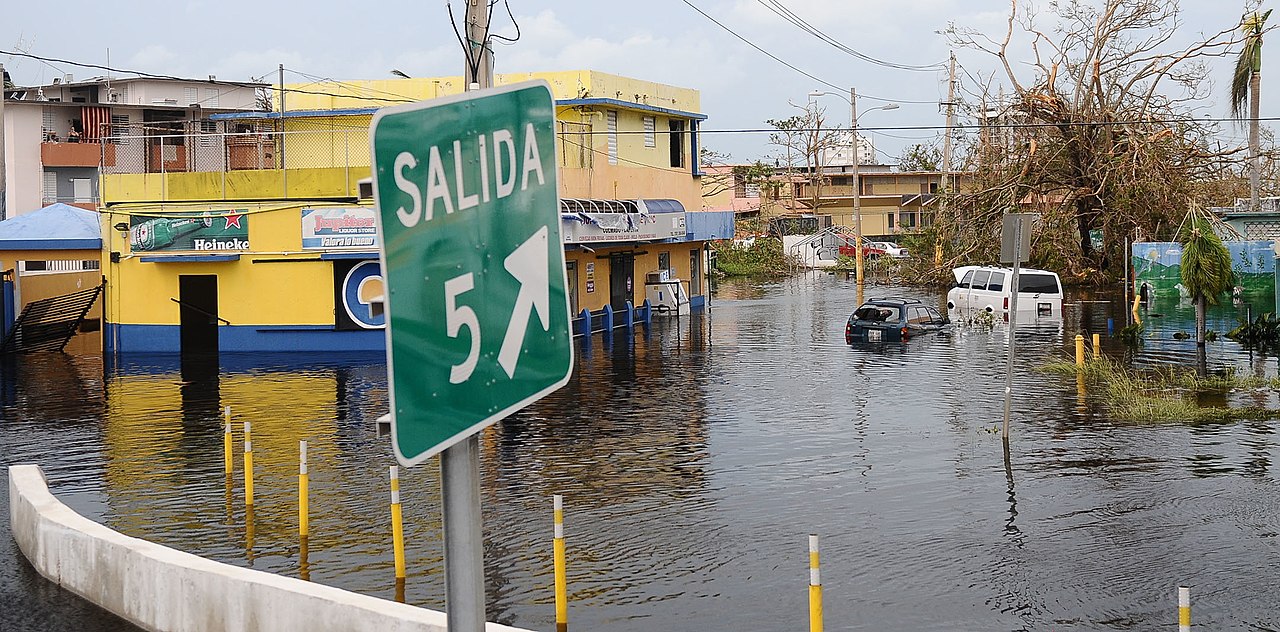

Flooding in Carolina, Puerto Rico (Public Domain)
By Dee Maitland
Hurricane season began on June 1, this is the fifth year in a row for storms to develop before the start of the season.
In this century, the worst hurricane season was in 2005, the year of Katrina, followed by 2017 when María that devastated Puerto Rico.
The National Oceanic and Atmospheric Administration (NOAA) is optimistically predicting a near normal season. Unfortunately, their prediction comes with only a 40% assurance of accuracy offset by a prediction with 30% assurance of accuracy that the season will be worse than average. NOAA does state that with recent technological upgrades they are more prepared than ever to predict storms in a timely manner, and for the first time they will be tracking the area that includes Puerto Rico.
NOAA’s predictions do not provide comfort for Puerto Rico since it has not successfully recovered from 2017 María devastation. The power grid still goes down weekly, thousands remain homeless and food stamp benefits are down by 25 percent.
The Senate recently passed a long stalled disaster relief bill of $19.1 billion, which includes more aid for Puerto Rico. The House passed it last Monday, and President Trump signed it last Thursday.
Unfortunately, Congress and Trump authorizing relief has little impact on Puerto Rico actually receiving the aid. Contrary to the president’s false claims that the U.S territory initially received $91 billion, Congress actually approved $41 billion, of which only $11 billion was disbursed. Further, of the additional $20 billion allocated last year, only $14,000 has been spent as of this past April.
Most of the disaster funding for Puerto Rico is handled by the Department of Housing and Urban Development (HUD) through its Community Development Block Grant Disaster Recovery program. It is HUD’s responsibility to develop the grant guidelines and application process. To date, $2 billion allocated for the power grid is still in limbo as HUD continues developing guidelines two years after María.
For Puerto Rico, the lack of development funds has created a downward spiral that will be hard to remedy. Without investment, businesses cannot rebuild and without power businesses cannot operate. Without restoration of roads, employees cannot get to work and goods cannot get to market. Without employment, citizens cannot pay for food, shelter or medicine. The visual of commercial and personal devastation has paradoxically led politicians to blame María victims for not being resourceful enough to recover without “government handouts.”
To avoid the cumbersome bureaucratic, politicized and time-consuming requirements of grants from agencies such as FEMA (Federal Emergency Management Agency) and HUD, a resourceful administration would immediately implement a microgrant program. Many banks and non-profit organizations (both nationally and internationally) would have been a valuable resource since they know how to administer these well-respected programs, and the simple application process would assure immediate benefit.
The microgrant focus is on awarding small sums—$50 to $500 for individuals to start an income-generating project; $2,000 to $10,000 for a community to work on impact-oriented projects. This quick infusion of funds would have had a tremendous impact on Puerto Rico, bringing communities together for inspiration, assistance and development; allowing individual entrepreneurs to form businesses; and saving government funds in the long run.
HUD Secretary Dr. Ben Carson recently demonstrated before Congress that he is ill-informed on key areas administered by the department. This incompetence is detailed in a March 2019 report by the Government Accountability Office (GAO), which states: “the Department of Housing and Urban Development doesn’t have the review guidance and monitoring plans it needs for good grantee oversight.” The GAO report makes five recommendations for improvement, which include “developing guidance for HUD staff to use in assessing grantees, developing a monitoring plan, and conducting workforce planning.” None of these recommendations, even if embraced by HUD, won’t impact this hurricane season.
One wonders if the lack of speed in problem-solving and road blocks HUD has placed on funds reaching Puerto Ricans is in response to the open animosity the president has shown. In April, when the mayor of San Juan challenged the lack of assistance, the President tweeted that she was “crazed and incompetent.” In the same tweet, he complained that Puerto Rico victims are taking money from “our farmers.” Apparently, he is unable to tell the difference between natural and man-made disasters.
NOAA has admirably increased its ability to predict storms and, in conjunction with the National Weather Service, has issued detailed guides on how to respond to severe weather. One of the main recommendations is to flee the path of the storm by moving to higher ground inland. Unlike other Americans, Puerto Ricans cannot move since an ocean and its oncoming hurricane separate them from any land-bound state. Unless the Trump Administration wants to relocate all Puerto Ricans to the mainland, it is way past time for government agencies like HUD and FEMA to improve their abilities in responding to disasters and for Congress to financially prepare for the inevitable next hurricane.
***
Dee Maitland is a retired commercial banker and a Public Voices Fellow with The Op-Ed Project.


